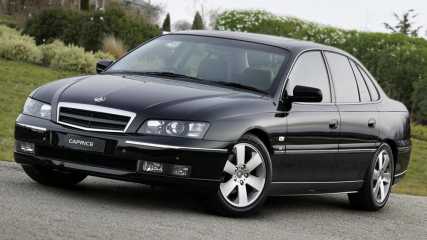Holden Statesman 2006 review
By Ashlee Pleffer · 05 Sep 2006
Holden impressed with the highly anticipated VE Commodore launch last month, with lights, cameras and well, a blimp. So for the luxury WM models, it's only natural that they went one step further this week by inviting the Prime Minister along.And while previously these cars may have conjured up an ideal audience of, let's say people of Mr Howard's era, the new WM models, to put it plainly, are more hip and stylish, yet still offer that level of sophistication and classiness.The Statesman and Caprice are available in both V6 and V8 engines, with the Caprice experiencing a considerable price drop over the previous WL models. At $69,990, the range-topping (and most expensive) WM model has dropped by $5400.The V6 Caprice has a $65,990 price point, $4700 less than its predecessor.The Statesman, on the other hand, has seen a slight increase in price, with the V6 now costing $58,990, compared with the previous $56,990 and the V8 priced at $62,990, $1300 more than the WL V8 Statesman.With their great, sturdy looks, impressive on-road performance and a lengthy list of goodies, it's no wonder the PM echoed the words of his predecessor, Ben Chifley, who also appeared at a Holden launch in 1948, in exclaiming: "I think she's a beauty, too", referring to both new models.The launch of the new long-wheelbase luxury sedans is the result of a $190 million investment, on top of the $1.03 billion VE program.The new models are made in the Elizabeth plant in Adelaide, and a tour around the factory showed the amazing process of the Matrix-like, animated robots, which almost seemed to have their own personalities, hard at work.When reaching full production in the coming weeks, the factory will produce 620 vehicles a day, which include WMs, VEs and the VZ Utes and wagons.The WM models differ from the shorter wheelbase VE Commodore, obviously with a stretched wheelbase providing more interior space, lengthened rear doors, an increased rear overhang, to name but a few of the exterior changes, and the new models have a wheelbase 70mm over the WL, but an overall length 32mm shorter.The 3.6-litre V6 produces 5kW more power and 5Nm more torque than the previous model, with 195kW at 6500rpm and 340Nm at 2600rpm.The 6.0-litre, V8 engine also experiences an increase in performance, with 270kW at 5700rpm, up from 260kW and 530Nm at 4400rpm, an increase of 20Nm of torque.The WM models are big cars and similarities can be seen to the Chrysler 300C. But on road they aren't as hard to manoeuvre as you'd expect, and tight turns and parking lots are easier to tackle than you initially think.Both models have great steering and go exactly where you point them. The Caprice has a sportier feel with firmer suspension compared with the Statesman. The V6 sounded a bit noisy, but that could just be the result of just having departed the quiet V8, where you could almost hear a pin drop.The Statesman is marketed as the "comfort prestige" model, while the Caprice has been given more aggressive styling, with a "prestige sport" persona. And while the differences between the two are minimal, they are noticeable, including the grilles, 18-inch, five-spoke wheels for the Caprice and 17-inch, 10-spoke wheels for the Statesman and different lamps for each. And if you think the Statesman has an impressive list of features, the Caprice goes even better.The Statesman comes with front and rear park assist, 11-speaker sound system with a six-disc CD player, MP3 and Bluetooth mobile-phone connectivity, eight-way electric front seats, night-mode dash illumination and auto rain-sensing wipers.The Caprice also offers a Bose audio system, an impressive DVD player, a tri-Zone electronic climate control system, and 10-way electric adjustment front seats.And what's a beauty without its jewels. These luxury vehicles are adorned with front fog lamps, grilles and badges, rear valance and exhaust tips, chrome bodyside moulding and Bi Xenon headlamps for the Caprice, all the jewelled elements for a sparkling finish.On the safety side, the WM models come with six airbags, Electronic Stability Program (ESP), traction control, electronic brake assist, anti-lock braking system and electronic brakeforce distribution. There's a notion of exclusivity attached to the luxury models and the interior is especially designed to match this description.The leather interior provides great comfort for all passengers, adding to the cosiness of the spacious cabin. The onyx with metro leather trim, in other words the black or darker leather interior, had a more stylish, sporty feel over the lighter, light urban leather. The interior also features wood trim.And the Caprice is particularly more suitable for the entertainment buffs, or those just wanting the "are we there yet?" cries to stop, with a DVD player featuring a roof-mounted speaker and rear DVD screens set into the headrests. The Statesman offers a roof mounted DVD player as an option.Fuel economy for the V6 in both models is 11.7-litres per 100km, and 14.7-litres per 100km for the more powerful V8. Holden says the target customers for the long wheelbase are those "fortysomething, successful and self-assured" buyers and it's the Caprice where Holden hopes to attract new customers.












